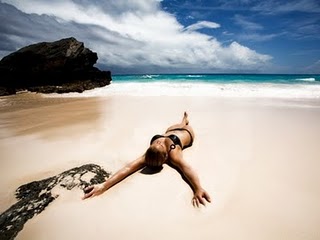Extensive, prolonged sun exposure without skin protection has been associated not only with premature aging of the skin but also with an increased risk of developing a variety of skin cancers, most commonly basal cell carcinoma, squamous cell carcinoma and malignant melanoma. The risks are far higher in those with fair skin than burns and lower in those who are dark complected. Tanning booths have also been identified as a highly efficient short-cut to developing these unwanted problems.
The method of action of the facilitating of accelerated aging and development of skin cancers is through ultraviolet radiation from the sun and tanning booth elements that penetrate through the top layers of the skin. The main culprits are ultraviolet B (UVB) and ultraviolet A (UVA).
The most obvious ways to minimize ultraviolet radiation damage to our skin is to decrease our sun exposure, protect our skin when we are out in the sun and to stay away from tanning booths. Applying effective sunscreens and wearing protective clothing can reduce our exposure to these harmful ultraviolet rays.
There is considerable confusion in determining what is an effective yet safe sunscreen due to the fact that so much of the available information as well as marketing is misleading and inaccurate. For example, the SPF number that is listed for a particular sunscreen applies only to the UVB rays and has no bearing on the protection provided, if any, to the more deeply penetrating and also damaging UVA rays. Unfortunately, there is no similar number or standard that we can use to assess and compare UVA protection levels. Compounding this problem even more is the fact that sunscreens with an identical SPF number do not offer the same level of protection.
Since 1978, the federal government has unsuccessfully attempted to regulate sunscreens with a variety of proposals. It now appears that there may be a more common sense plan that will allow the consumer to be far more informed when trying to decide which brand to buy. Of course, only time will tell if this will be the case. This system will not be implemented until next year.
In essence, there will be a standardization of terminology and claims which also involves the abolishment of the terms “sunblock”, “waterproof” and “sweat-proof”. The term “broad spectrum” can be claimed by those sunscreens that meet the specified criteria. “Water-resistant” can be used but manufacturers will have to specify whether this is for 40 or 80 minutes. Ratings above an SPF of 50 will not be allowed as there is no evidence that any of the products provide this level of protection.
As part of the continuing quest to maintain youthful looking skin as long as possible, we must remember to minimize our sun exposure, refrain from using tanning booths, avoid smoking and effectively use sun protection techniques daily. With the advent of what appears to be a more helpful way of assessing the effectiveness of sunscreens, we may just have more success in preserving our looks.
For more information on skin care, skin care products or even skin cancers or to schedule a consultation, you can call my office at 480-451-3000. We also offer a wide variety of skin care products in office as well as at our online skin care store that may help meet your personal needs.
Steven H. Turkeltaub, M.D. P.C.
Scottsdale and Phoenix, Arizona

